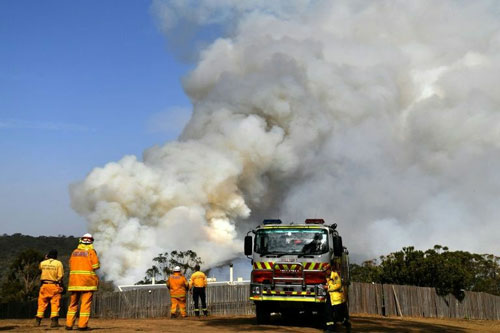Merimbula, Australia
Massive bushfires in southeastern Australia have a “long way to go”, authorities have warned, even as colder conditions brought some relief to exhausted firefighters and communities on Saturday.
After a blustery night that saw a series of massive infernos in New South Wales and Victoria states merge into a mega-blaze four times the size of Greater London, temperatures dropped and rain fell on fire-scarred regions.
“Whilst it was a very long and—in parts of New South Wales—difficult night, we’re relieved this morning that no lives have been lost and no substantial property damage,” New South Wales Premier Gladys Berejiklian told reporters on Saturday.
The milder conditions are expected to last around a week, giving firefighters time to try to get the fires under control.
New South Wales Rural Fire Service commissioner Shane Fitzsimmons described the conditions as the “best seven days we have had without a rise of very dangerous fire ratings”.
In a matter of months, the catastrophic bushfires have killed at least 26 people, destroyed more than 2,000 homes and scorched some ten million hectares (100,000 square kilometres)—an area larger than South Korea or Portugal.
University researchers estimate that more than one billion mammals, birds and reptiles have been killed in the blazes.
Despite the cool change, authorities warned that the bushfire season is not yet over, with hundreds of fires across several states still raging.
In Victoria state, Premier Daniel Andrews called on communities to remain vigilant and warned that the months-long crisis was “a long way from over”.
The head of a firefighting “strike team” in the New South Wales village of Towamba, Nathan Barnden, told AFP the rainfall was “fantastic” but “not enough at this stage to put these fires out”.
“We’re going to need hundreds of millimetres over a period of time to… make firefighting easier for us,” he said. – ‘Take stronger action’ –
On Friday, tens of thousands of protesters took to the streets across the nation’s cities, calling on Australia’s conservative government to take stronger action on climate change.
Scientists say climate change has contributed to the lengthening of the fire seasons and fuelled more frequent and intense blazes.
The Australian Academy of Science, an independent organisation representing the country’s leading scientists, said Canberra “must take stronger action” as part of its global commitments to limit global warming.
“The scientific evidence base shows that as the world warms due to human-induced climate change, we experience an increase in the frequency and severity of extreme weather events,” the academy’s president John Shine said in a statement.
“As a nation, we must deal with extreme weather events more effectively than we currently do.” Australia experienced its driest and hottest year on record in 2019, with its highest average maximum temperature of 41.9 degrees Celsius (107.4 degrees Fahrenheit) recorded in mid-December.
Despite growing domestic and international criticism, Prime Minister Scott Morrison—who has long touted the importance of commodity exports such as coal for Australia’s economy—has repeatedly defended his government’s climate policies.
The unprecedented crisis has also sparked an outpouring of fundraising from celebrities, sportspeople and locals in support of volunteer firefighters at the frontlines and devastated communities. The Sydney Opera House will project images shot during the fires onto the building’s sails Saturday, ahead of a comedy gala fundraiser.—APP










